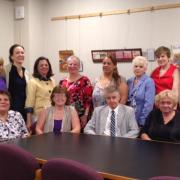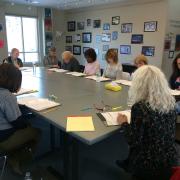Intergenerational
The Art of Acting: Preparing and Presenting a Dramatic Staged Reading
$2,501-5,000
Editor’s note: This Program Model is part of a series highlighting the work of the Lifetime Arts Affiliates, a cohort of 20 libraries that has been working with Lifetime Arts Inc. to launch professionally conducted arts education for older adults. For more information, check out Lifetime Arts' Creative Aging Toolkit for Public Libraries, a free online resource for librarians that provides information about creative aging research, best practices, and practical advice for planning and implementing creative aging programs.
***
This 12-week acting workshop for adults 55+ was led by a director/teaching artist under a model created by Lifetime Arts. It was designed for actors of any level, including absolute beginners. Participants experienced firsthand the joys and camaraderie of preparing, rehearsing and presenting a dramatic staged reading. The program culminated in a performance of "Twelve Angry Jurors" on June 7, 2015.
Advanced Planning
Our goals for this program were to allow participants to step outside of their comfort zone and learn new skills in a supportive, safe environment. We hoped they would continue on in some manner (e.g., community theater, a play reading group). We began planning several months in advance. We hired a director/teaching artist, and she worked along with the assistant director of the library.
I chose "Twelve Angry Jurors" because I thought it would lend itself to this project. For seniors, there would not be a lot of physical action, and since we wanted to do a staged reading, jurors usually have a notebook. The notebooks were the actors' scripts.
Marketing
We promoted the availability of the workshop to local newspapers online and in print. We promoted to neighboring libraries, online calendar/event sites, and in our own library newsletter. We also promoted to patrons taking part in other library programs.
We ended up with 14 actors; they played the 12 actors, the judge and the guard. We initially had two more participants, but they dropped out. We originally had hoped to have one or two understudies, but that did not happen.
Budgeting
The bulk of the money, $2,450, went to the teaching artist/director. The balance was what you would expect: materials and supplies, scripts, programs and refreshments for the reception at the culminating event, which followed the performance.
Day-of-event Activity
The first 10 sessions were a combination of exercises and rehearsals. The first part of the session was spent doing an exercise given by the teaching artist/director. Additionally, there was usually a homework assignment, so that was reviewed. This part of rehearsal was usually spent sitting in a circle of chairs. The second half of the session was spent actually rehearsing the play. The rehearsal was mostly spent sitting at the jurors' table, which served as the set. The 11th session was a full dress rehearsal.
The end result was a fully staged play; although scripts were used, there was some action as well. In one or two cases, some adjustments were made for actors who were not comfortable or fit enough to get up and move around, but otherwise the production followed the script as much as possible.
Several of the possible participants were afraid of acting in front of an audience, so it took time to persuade them to get involved. Once we were in full swing, some of the actors were hyper-focused on their own roles/characters, and continually made suggestions and wanted to make changes to their own character. We had to reel them in a bit to focus on the entire play and everyone as a group. It's natural for people to focus on themselves, but when a project is a true ensemble, the attention has to be spread around and the group is more important than any individual.
The 12th session was our performance and receiption. The day of the event, we set up the room where the performance took place, as well as for the reception space. We had four staff members on hand for the set-up and clean-up. We had no unexpected challenges.
Program Execution
Between the cast and audience, approximately 100 people attended the final performance. The cast thoroughly enjoyed themselves, and the audience loved the play. In fact, the cast performed an encore of the play at a local veteran's nursing home a week or two later.
We received some wonderful feedback from our participants:
"Participating in last year’s production was a surprising and totally positive experience for me! Surprising for me in that I have never done anything like this before. … Being a senior and somewhat of a recluse, I feel I was indeed fortunate to discover this library program and the wonderful, caring people who made it possible.” – Diana Marcus
“This program gave me the opportunity to actually act in a play, something I never did in my younger days.” – Anna DeAngelis
“I enjoyed myself, did something new, met new people, felt my life was fuller while the rehearsals were going on.” – Claire Herzberg
Advice
My advice would be that there are a lot of moving parts in taking a program like this on; however, if you are very organized, it is well worth the hard work. A staff member who can be fully dedicated to the workshops, as far as prep and being there each week, is a definite must.






